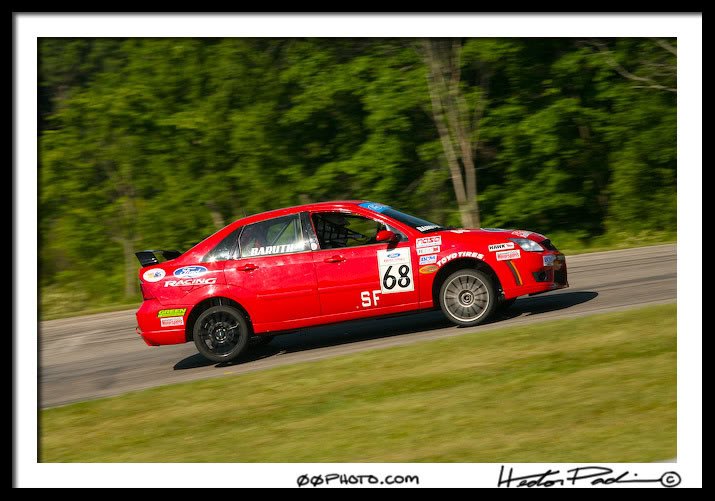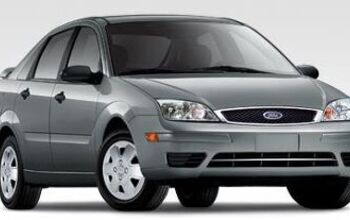Capsule Review: 2007 Ford Focus ZX4 ST "Spec Focus"

TTAC tested the street version of this car a few years ago: check it out for a classic example of mid-RF-era TTAC reviews, complete with withering attention to interior-quality issues and not-so-gentle comments regarding the unwillingness of the average automaker to purchase a Ford.
At the time, the Focus sold for about fifteen grand. That was for the street car. How much does a racing Focus cost? The answer: One dollar. The answer is also $2500. And $6000. And $25,000. Confused yet?
The success of the Spec Miata racing class, both in the eager-to-embrace-it NASA and hideously-reluctant SCCA, was a pointed lesson to manufacturers struggling to build enthusiast bases for their cheap-and-cheerful cars. A few more spec street-car classes were spontaneously spawned from owner interest: the SE-R Cup, Spec Neon, and Spec E30 (BMW) classes all managed to get off the ground and running with little or no manufacturer help.
The Spec Focus class, on the other hand, was a deliberate creation of a few well-known Ford engineers and marketroids. A couple of so-called “dollar cars” were signed over to Leo Capaldi Racing, which had previously campaigned a Focus in Speed World Challenge competition. “Dollar cars” are cars which cannot be sold to the public for some reason. Normally they are crushed; VW, for instance, crushed the Phaetons by its reps to travel the country and train mechanics on Phaeton service. They might as well have crushed it before sending it out, if the quality of Phaeton service I received is any indication of said training program, but I digress.
Capaldi built the cars to a very high standard, finishing the cage and preparation almost to a Grand-Am Cup level — which, as we will later see, wasn’t the greatest idea. The coin-operated people at NASA were easily persuaded to carve out a separate class for the three Foci to race, and thus Spec Focus was born.
Ford engineers did a lot of homework to ensure that the four major Focus variants — 2.0 Zetec, 2.0 Zetec SVT, 2.0 Duratec, and 2.3 Duratec — would all produce about the same power with the permitted parts. A rather modest National Championship was held in 2006 among the rental cars, with a Ford SVT engineer thrown in to make sure there were enough competitors to round out a podium.
In 2007, two private competitors built their own Spec Foci and all of a sudden it was a five-car class. I joined Spec Focus as a renter, paying between $2500 and $3500 a weekend to drive the red ZX4 sedan. It was a complete arrive-and-drive program for me; I just showed up, paid, and was given a well-prepared car. When necessarily, Capaldi himself suited up to give me some competition. Just watching him race was worth the money; a lifetime racing in murderous Detroit kart classes and Speed WC had taught him every trick in the book and then some.
With Capaldi’s guidance and coaching from a variety of reasonably distinguished fellows, I obliterated the lap records set by the 2006 champion and prepared to cruise to a nearly uncontested 2007 National Championship. The private cars weren’t even close to Capaldi’s rent-a-racers; at one Mid-Ohio race I ran a 1:45.6 while the fastest private car ran 1:51. To put this in perspective, a reasonably-skilled “HPDE 3” driver in a completely stock 911 GT3 or Corvette Z06 might expect to run a 1:43. These weren’t slow cars; although they only made 170hp or so at the wheels, grippy Toyo RA-1 tires and high-quality Multimatic suspension made them quick in the turns.
What’s a Focus race car like to drive? Well, it likes to roll:
My driving style was different from everyone else’s in the class; I have a particular touch for loading up an outside sidewall and I ended up deflating a tire during a race from bead separation under conditions worse than pictured above. (As a result, Ford changed the tire spec for 2008.) This was not a car for the faint of heart or stomach to race; although the handling was very safe, there was a lot of motion in the car. On the plus side, it had ABS, which absolves a multitude of driving sins.
Most importantly, however, a Spec Focus is a race car. That means: no interior trim anywhere, very loud inside, no rubber or slop in the bushings, full cage, deep seat, limited visibility. It actually feels a lot more like a conventional racer than a Spec Miata, which is not as obviously transformed in its journey from street car to race car.
During the 2007 National Championship itself I made a mistake going into the first turn, dropping into third place, and then kicked another driver into the dirt making up the time. Although I set fast lap of the race, I was demoted down to the third step of the podium in the disciplinary session afterwards. Including damages, entry fees, and incidentals, that was a $6000 weekend. Had I totaled the car, I would have had to write Leo a $25,000 check. When people asked me why I raced an economy car, I always replied,
“Because it’s only slightly more expensive than leasing a Murcielago.”
Despite the obvious merits of the cars, private racers have been slow in coming. I suspect it’s because racing against a fully-prepared team like Capaldi Racing is tough enough for other pro teams. For a guy with an open-deck trailer and a $300 Craftsman toolset, it’s even tougher. No private Spec Focus racer has experienced significant success.
My experience as a rent-a-driver convinced me that I could run my own team, and I was more or less correct. The Neon I built for a total of $9500 the next year was slightly faster than Capaldi’s Focus rentals and far ahead of the private Foci. I had the satisfaction of lapping one of my most outspoken critics in the Focus community during a 2008 race. Later on in the season, one of the Spec Focus drivers and I came together in a collision that totaled my Neon and put the other driver on the Life Flight, but that’s a story for another time. Eighteen months later, everybody’s friends. Things happen in racing. It isn’t World of Warcraft; temper can cost lives.
Capaldi Racing can still put you behind the wheel of a Spec Focus; click for details. The class hasn’t had a lot of subscription in 2010, but it’s a solid way to get started in your race career. The conventional wisdom is that it’s better to start in a large class like Spec Miata, but I found that having a relatively small number of in-class cars at every race allowed me to, ah, focus on getting my personal act together as a driver and racer. It might be the right choice for you, as well.

More by Jack Baruth
Latest Car Reviews
Read moreLatest Product Reviews
Read moreRecent Comments
- SCE to AUX All that lift makes for an easy rollover of your $70k truck.
- SCE to AUX My son cross-shopped the RAV4 and Model Y, then bought the Y. To their surprise, they hated the RAV4.
- SCE to AUX I'm already driving the cheap EV (19 Ioniq EV).$30k MSRP in late 2018, $23k after subsidy at lease (no tax hassle)$549/year insurance$40 in electricity to drive 1000 miles/month66k miles, no range lossAffordable 16" tiresVirtually no maintenance expensesHyundai (for example) has dramatically cut prices on their EVs, so you can get a 361-mile Ioniq 6 in the high 30s right now.But ask me if I'd go to the Subaru brand if one was affordable, and the answer is no.
- David Murilee Martin, These Toyota Vans were absolute garbage. As the labor even basic service cost 400% as much as servicing a VW Vanagon or American minivan. A skilled Toyota tech would take about 2.5 hours just to change the air cleaner. Also they also broke often, as they overheated and warped the engine and boiled the automatic transmission...
- Marcr My wife and I mostly work from home (or use public transit), the kid is grown, and we no longer do road trips of more than 150 miles or so. Our one car mostly gets used for local errands and the occasional airport pickup. The first non-Tesla, non-Mini, non-Fiat, non-Kia/Hyundai, non-GM (I do have my biases) small fun-to-drive hatchback EV with 200+ mile range, instrument display behind the wheel where it belongs and actual knobs for oft-used functions for under $35K will get our money. What we really want is a proper 21st century equivalent of the original Honda Civic. The Volvo EX30 is close and may end up being the compromise choice.



































Comments
Join the conversation
I'm working on becoming a racer/driver. I can barely afford my everyday car though, so I started with books, Gran Turismo and making the best out of every on/off ramp.
It's funny when in Spec Miata they give awards for least amount of "in class" body contact (lol).